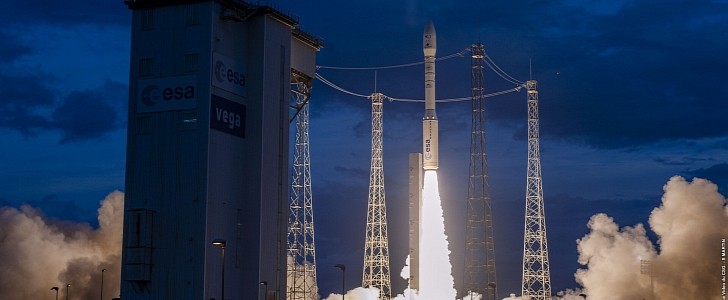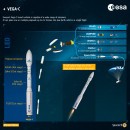On Tuesday, November 16th, an Arianespace Vega rocket launched from Europe’s Spaceport in French Guiana, carrying three CERES satellites for the French Ministry of Defence to Earth’s low orbit. The recent launch marked the 20th successful mission completed by the Vega launcher, clearing the way for its more powerful successor: Vega-C.
Vega is the European Space Agency’s satellite launch vehicle and has been in operation at Europe’s Spaceport since February 2012. It has launched a total of 111 satellites into orbit, showcasing impressive capabilities in both orbital and suborbital missions.
The recent flight was the rocket’s third launch performed in the last six months. Built by Airbus Defence and Space, the three satellites carried by Vega will circle our planet to detect signals from radars and radio communication systems located in regions where surface sensors cannot reach.
The launcher’s latest successful flight validated its ability to carry “strategically important” satellites into orbit, clearing the way for Vega’s successor: Vega-C. Following the 20th flight, there will be a period of transition during which both vehicles will be deployed for various missions.
The new rocket is based on the Vega launch vehicle, which consists of four stages: three solid-propellant stages, an upper fourth stage, and a payload fairing. However, the fairing is larger on Vega-C.
The spacecraft will be capable of carrying out more launches each year and will have an increased payload capacity (with 1,764 lbs/ 800 kgs more) compared to its cousin. Although it will be larger, the rocket will not add to the launch costs.
Actually, the costs will remain the same as for Vega, thanks to the P120C motor. And that’s not all. The new launcher will support a wide variety of payload carriers that will be used for different payloads.
Vega-C is expected to conduct the first flight in the first quarter of 2022. Until then, the European Space Agency “will oversee this transition, build on the accomplishments of Vega and prepare future adaptations for a Vega-E suitable for a rapidly evolving and competitive market.”
The recent flight was the rocket’s third launch performed in the last six months. Built by Airbus Defence and Space, the three satellites carried by Vega will circle our planet to detect signals from radars and radio communication systems located in regions where surface sensors cannot reach.
The launcher’s latest successful flight validated its ability to carry “strategically important” satellites into orbit, clearing the way for Vega’s successor: Vega-C. Following the 20th flight, there will be a period of transition during which both vehicles will be deployed for various missions.
The new rocket is based on the Vega launch vehicle, which consists of four stages: three solid-propellant stages, an upper fourth stage, and a payload fairing. However, the fairing is larger on Vega-C.
The spacecraft will be capable of carrying out more launches each year and will have an increased payload capacity (with 1,764 lbs/ 800 kgs more) compared to its cousin. Although it will be larger, the rocket will not add to the launch costs.
Actually, the costs will remain the same as for Vega, thanks to the P120C motor. And that’s not all. The new launcher will support a wide variety of payload carriers that will be used for different payloads.
Vega-C is expected to conduct the first flight in the first quarter of 2022. Until then, the European Space Agency “will oversee this transition, build on the accomplishments of Vega and prepare future adaptations for a Vega-E suitable for a rapidly evolving and competitive market.”






